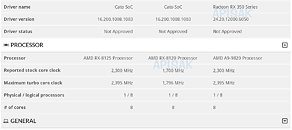- Joined
- Oct 9, 2007
- Messages
- 47,636 (7.44/day)
- Location
- Dublin, Ireland
| System Name | RBMK-1000 |
|---|---|
| Processor | AMD Ryzen 7 5700G |
| Motherboard | Gigabyte B550 AORUS Elite V2 |
| Cooling | DeepCool Gammax L240 V2 |
| Memory | 2x 16GB DDR4-3200 |
| Video Card(s) | Galax RTX 4070 Ti EX |
| Storage | Samsung 990 1TB |
| Display(s) | BenQ 1440p 60 Hz 27-inch |
| Case | Corsair Carbide 100R |
| Audio Device(s) | ASUS SupremeFX S1220A |
| Power Supply | Cooler Master MWE Gold 650W |
| Mouse | ASUS ROG Strix Impact |
| Keyboard | Gamdias Hermes E2 |
| Software | Windows 11 Pro |
AMD could be giving finishing touches to its new generation of embedded SoCs codenamed "Cato." The chips surfaced on screenshots of UL Benchmarks (Futuremark) SystemInfo, across three models: the RX-8125, the RX-8120, and the A9-9820. For the uninitiated, the RX series embedded processors are part of the company's Ryzen Embedded family. The RX-series are differentiated from the A-series either by microarchitecture, or lack of unlocked multipliers, or other features, such as integrated graphics.
"Cato" is shrouded in mystery. One possible explanation could be AMD manufacturing the existing "Raven Ridge" IP on its refined 12 nm process, and "Zen+" enhancements to its CPUs. SystemInfo reading 8 logical processors could be a case of a 4-core/8-thread CPU configuration with SMT enabled. Another theory pegs this to be a new silicon, based on new IP, and 8 CPU cores. This is less probable since AMD is less stingy with SMT across its product-stack, and is hence less likely to deprive an 8-core silicon of SMT. If the latter theory is true, then this could simply be a case of the SystemInfo module not correctly detecting the prototype chips.

Moving on to the chips themselves, there is mention of an RX-8125 SoC with "8 logical processors," and CPU frequency swinging between a wafer-thin Boost headroom of just under 100 MHz. The chip's nominal clock is 2.30 GHz, and its boost frequency roughly 2.40 GHz. The RX-8120 comes with a similar CPU configuration, but significantly lower clock speeds, of 1.70 GHz core, and 1.80 GHz boost. Perhaps this chip is an energy-efficient "E" extended SKU. Lastly, there's the A9-9820, which is a full-fledged APU with an integrated graphics core labeled "Radeon RX 350 series." What gives this chip an A-series branding is probably the lack of an unlocked multiplier.
View at TechPowerUp Main Site
"Cato" is shrouded in mystery. One possible explanation could be AMD manufacturing the existing "Raven Ridge" IP on its refined 12 nm process, and "Zen+" enhancements to its CPUs. SystemInfo reading 8 logical processors could be a case of a 4-core/8-thread CPU configuration with SMT enabled. Another theory pegs this to be a new silicon, based on new IP, and 8 CPU cores. This is less probable since AMD is less stingy with SMT across its product-stack, and is hence less likely to deprive an 8-core silicon of SMT. If the latter theory is true, then this could simply be a case of the SystemInfo module not correctly detecting the prototype chips.

Moving on to the chips themselves, there is mention of an RX-8125 SoC with "8 logical processors," and CPU frequency swinging between a wafer-thin Boost headroom of just under 100 MHz. The chip's nominal clock is 2.30 GHz, and its boost frequency roughly 2.40 GHz. The RX-8120 comes with a similar CPU configuration, but significantly lower clock speeds, of 1.70 GHz core, and 1.80 GHz boost. Perhaps this chip is an energy-efficient "E" extended SKU. Lastly, there's the A9-9820, which is a full-fledged APU with an integrated graphics core labeled "Radeon RX 350 series." What gives this chip an A-series branding is probably the lack of an unlocked multiplier.
View at TechPowerUp Main Site


